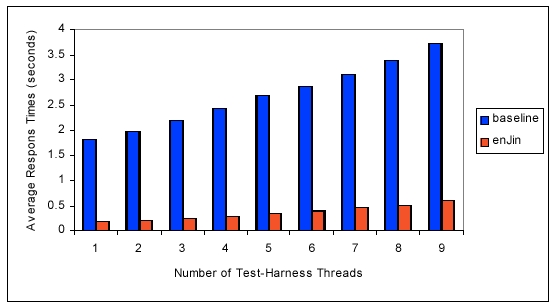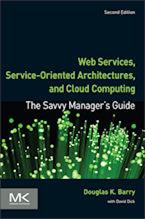Benchmark Using a Transaction Accelerator
A benchmark, conducted by IBM's High Volume Websites (HVWB) Lab, compared the performance of IBM's WebSphere Application Server and DB2 with and without Versant's enJin product.1 The benchmark is a stock trading application with simple and complex transactions.
Versant no longer markets enJin. Nevertheless, this benchmark is still valid and illustrates the performance gain when using an object database in the middle tier. Versant called its enJin product a "transaction accelerator." It worked with Java application servers in much the same way as described in the other architectures that you can find in the related content below. The enJin product was built upon Versant's object database management system.
The performance gains possible with an object database in the middle tier are illustrated in the following graphs. They compare performance with and without enJin in the J2EE architecture. In the "baseline" architecture referred to in these graphs, WebSphere is used with DB2. The same architecture was then used with enJin added to the middle tier between WebSphere and DB2.
The first graph shows response times for simple transactions. These are new trades in the stock trading benchmark. At 10 test-harness threads, the baseline configuration response time was 900 milliseconds compared to 160 milliseconds for the configurations with enJin.

The second graph shows response times for more complex transactions. These are new portfolio transactions in the stock trading benchmark. At 10 test-harness threads, the baseline configuration response time was 3,730 milliseconds compared to 600 milliseconds for the configurations with enJin.

So, it is pretty easy to make the case that with this accelerator in the middle tier, you can either have higher capacity with the same hardware or you can use less expensive hardware. The white paper gives an example of such a calculation.
Note: Similar results can be achieved using an XML database in the middle tier. An architecture along with performance charts similar to the two shown above can be found in Chapter 5, Solve Performance Problems with FastSOA Patterns, in FastSOA by Frank Cohen.
? The information on this benchmark is used with permission from Versant Corporation. The full benchmark paper is available here.
Context for Benchmark Using a Transaction Accelerator
Related Articles for Benchmark Using a Transaction Accelerator
Author
Douglas K Barry
Principal
You may use this material for your work or classes. Reprint Policy. Be sure to check the menu at the left for other articles available on this site.
The Savvy Manager's Guide
Douglas K Barry is also the author of a book that explains Web Services, service-oriented architecture, and Cloud Computing in an easy-to-understand, non-technical manner.
Web Services, Service-Oriented Architectures, and Cloud Computing: The Savvy Manager's Guide (Second Edition)
by Douglas K Barry with David Dick
This is a guide for the savvy manager who wants to capitalize on the wave of change that is occurring with Web Services, service-oriented architecture, and—more recently—Cloud Computing. The changes wrought by these technologies will require both a basic grasp of the technologies and an effective way to deal with how these changes will affect the people who build and use the systems in our organizations. This book covers both issues. Managers at all levels of all organizations must be aware of both the changes that we are now seeing and ways to deal with issues created by those changes.

